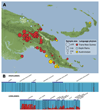A Neolithic expansion, but strong genetic structure, in the independent history of New Guinea
- PMID: 28912245
- PMCID: PMC5802383
- DOI: 10.1126/science.aan3842
A Neolithic expansion, but strong genetic structure, in the independent history of New Guinea
Abstract
New Guinea shows human occupation since ~50 thousand years ago (ka), independent adoption of plant cultivation ~10 ka, and great cultural and linguistic diversity today. We performed genome-wide single-nucleotide polymorphism genotyping on 381 individuals from 85 language groups in Papua New Guinea and find a sharp divide originating 10 to 20 ka between lowland and highland groups and a lack of non-New Guinean admixture in the latter. All highlanders share ancestry within the last 10 thousand years, with major population growth in the same period, suggesting population structure was reshaped following the Neolithic lifestyle transition. However, genetic differentiation between groups in Papua New Guinea is much stronger than in comparable regions in Eurasia, demonstrating that such a transition does not necessarily limit the genetic and linguistic diversity of human societies.
Copyright © 2017, American Association for the Advancement of Science.
Figures




Comment in
-
Papua New Guinea's genetic diversity withstood farming.Science. 2017 Sep 15;357(6356):1086. doi: 10.1126/science.357.6356.1086. Science. 2017. PMID: 28912225 No abstract available.
References
-
- O'Connell JF, Allen J. The process, biotic impact, and global implications of the human colonization of Sahul about 47,000 years ago. J Archaeol Sci. 2015;56:73–84.
-
- Denham T, Barton H. The emergence of agriculture in New Guinea: a model of continuity from pre-existing foraging practices. In: Kennett DJ, Winterhalder B, editors. Behavioral Ecology and the Transition to Agriculture. 2006. pp. 237–264.
-
- Lewis MP, Simons GF, Fennig CD. Ethnologue: Languages of the World. Nineteenth edition. 2016.
-
- Pawley A. The chequered career of the Trans New Guinea hypothesis: recent research and its implications. In: Pawley A, Attenborough R, Golson J, Hide R, editors. Papuan Pasts: cultural, linguistic and biological histories of Papuan-speaking peoples. 2005. pp. 67–107.
Publication types
MeSH terms
Grants and funding
LinkOut - more resources
Full Text Sources
Other Literature Sources

